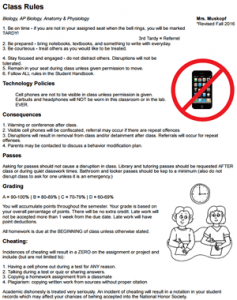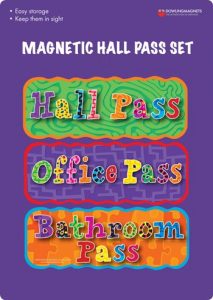
My very first day of school over twenty years ago, I received some very bad advice about classroom rules. For some reason, my education instructors at the time were very into student centered rule making. The first day, they said, should be spent by creating rules with the class so that the students are invested in the rules and understand why they are needed. It turned out that this was a terrible idea.
It wasted a ton of time, students were nervous about proposing rules and the ones that did ended up setting themselves up to be bullied by kids who don’t like to follow rules.
I strongly advise new teachers against this strategy. I could probably handle it now, but only by effectively steering the conversation of the class toward the rules I intended them to have anyway. I can skip all that by just setting out very clear guidelines on the first day.
I change my rules every year, though the basic format remains the same with the same basic behavior expectations. Over the years, I’ve had to add guidelines about technology use and cheating. I also change rules dependent upon the age group of my classes.
Freshman classes need a lot more specific guidelines, whereas seniors don’t need to be micromanaged as much. For example, I added a “do not get out of your seat without permission” rule for my classes this year because I will have a class of freshman. I know from experience, that freshman like to wander and will randomly get up in the middle of a class lecture to go sharpen a pencil, get paper from a friend, or just to see what someone across the room is doing.

1. Guidelines: Start with general or even vague guidelines of what is expected as acceptable behavior. Do not try to make rules against every possible thing kids might do, as you will never be able to come up with everything. One year, I had a student stick a dissecting needle in an outlet, which gave him a nice shock and burned the wall. My rules never said to NOT do that, but it would fall under my “Stay focused and don’t cause disruptions” rule. This rule actually covers most infractions that might occur in my classroom.
2. Technology: Include a section for technology policies that should align to your district policies. In my case, technology rules are left to the classroom teacher. I allow my students to use cell phones at the end of class to take practice quizzes on quizlet, so I don’t ban them altogether.
3. Consequences: Include a consequences section, but again keep it very vague. This leaves you a lot of room to address problems in ways that make sense for the class and for individual students.

4. Passes: Discuss rules for leaving the class and use of passes. This is probably the area I spend the most time with on the first day as my younger students will often forget homework or need to use the restroom, or just decide to leave class and wander the halls. I have a procedure for this, which includes a magnetic hall pass and a *sign signal for requesting to go to the bathroom. Only one student is allowed out of the class at a time.
5. Assignments: Include a section on how assignments will be graded and turned in and include any penalties for late work. You can also go into detail here about how projects and homework is generally assessed. I warn my students that the majority of their grade will come from chapter tests and there is no extra credit.
6. Academic Dishonesty: Cheating is addressed in my rules because of issues in the past year where students were unaware of what constituted cheating and the consequences.
7. Absences: Include policies for absences and make-up work.
8. Contact: Include contact information and website for the class and instructor’s email address. I also include social media information because I post information on twitter for my anatomy students.
My current incarnation of the rules is designed to fit on a single page (reducing the number of copies I need to make) and applies to all of my classes. I have a very diverse group of students, ranging from 9th grade biology students to senior honors biology. I did not want to make different rules for each, especially considering that my administration requires my rules to be posted somewhere in the room. At one point, I had rules so extensive and long that it would cover 3-4 pages and take more than a day to go over. Students would only remember about 50% of what was on it.

